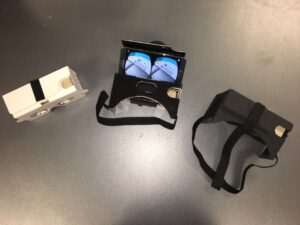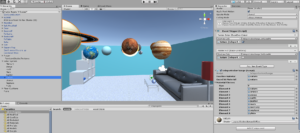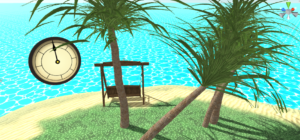A Virtual Reality-Based Calm Room for Children with Autism Spectrum Disorder
ABSTRACT
The Center for Disease Control identifies that 1 in 68 children are identified as having an autism spectrum disorder, but due to the high cost of treatment and intervention programs, many families cannot afford the care that their child needs. Although some treatment methods, such as service dogs, robotic assistance, and counselors, have been proven effective, these solutions are too cost-prohibitive to reach out to autistic children from all socioeconomic backgrounds. With the widespread availability of phones and inexpensive virtual reality headsets, however, this could change. Today, many amusement parks and other public areas have started creating calm rooms, a quiet place where children with special needs, particularly autism, can escape from the anxiety and stress from the sensory overload caused by the outside world. In this work, a virtual calm room has been developed and packaged (Unity3D, San Francisco, CA) such that it can easily be deployed on mobile devices, including Android and iOS devices. This virtual reality calm room will give parents an affordable and portable method of helping their child with autism and could also grant families more freedom to participate in activities outside the home without having to worry whether it will cause too much stress for their child.
INTRODUCTION.
Autism spectrum disorder severely impacts the lives of many citizens, but due to the high cost of treatment and intervention programs, many families cannot afford the care that their child needs. As the prevalence of autism grows, so does the cost of effective treatment and intervention programs. Autism affects 1.5% of all American children. Autism also affects nearly four times as many boys as it does girls. [1]
Recent research shows that children with autism respond negatively to sensory overload very early on, but anxiety drastically increases during their childhood [2]. Reducing this anxiety could improve the lives of these children significantly. Although this anxiety certainly affects the emotional health of children with autism spectrum disorder, it can also lead to physical harm. In fact, nearly 30% of children with autism suffer from self-injurious behaviors [3]. The combination of anxiety and self-harm can bring large amounts of stress and financial concerns upon families that have children with autism. Families recognize the need to address these problems, but often do not have access to effective tools or therapies to do so.
Currently, several research groups have investigated using robots or eye-tracking technology to treat these children without the need of a therapist [4]. Children with autism spectrum disorder have responded positively to the majority of these robots. Interacting with robots has been proven to improve the social interactions of children with autism. One of the most noticeable areas of improvement in interaction with a robot instead of a human therapist is eye contact, one of the most basic aspects of social interaction. When interacting with robots, children with autism made eye contact with the robot at approximately the same rate as typically developed children of the same age made eye contact with a human therapist [5]. These new types of therapy have yet to be widely accepted by clinicians due to a lack of solid evidence of their efficiency and capability. Many researchers are still investigating the potential use of robots in the future, but it likely will not be available, especially at an affordable price, to the public in the near future [6]. Although this could improve the convenience of treatment, it would not help many lower and middle-class families who cannot afford the expenses of this technology.
Virtually reality has been used to help children with autism spectrum disorder learn crucial skills for independence. One example of this is driving simulators that teach autistic teenagers to drive without exposing them to the dangers of driving in real traffic. This can help ensure that autistic teenagers are prepared to respond to unexpected events that can arise while driving. Measurements taken from eye gaze were used to determine the cognitive load of the teenager with autism. These measurements were used to determine the difficulty of the driving simulator. By tailoring the driving experience to the individual, this virtual reality driving simulator can create realistic driving experiences that will help the driver learn more about driving on real roads [7].
In recent years, virtual reality has gained prominence in the technological world. VR sets, which once were incredibly expensive and uncomfortable, can now be purchased for less than six dollars, although more expensive options still exist. Google has even published documents detailing how to make Google Cardboards, one of the cheapest and most reliable virtual reality headsets currently available. Google cardboards come in a rectangular box and can easily and quickly be folded into a virtual reality headset. Optional head straps can be added to the set (Figure 1). Many other types of inexpensive virtual reality sets, some of which may better suite an individual child’s sensory needs, are also available. Companies have started using virtual reality to allow people to take in the views from the international space station, try on clothing before purchasing it, and travel to other countries. As smartphones have become more common, people’s access to virtual reality has increased [8].
Figure 1. Three Google Cardboards in various states of assembly.
A system for intervention and therapy for autistic children made of low-cost and widely available materials has yet to be created. This project aims to use smartphones, which nearly 70% of American adults already own [9], and Google Cardboards, which cost under ten dollars, to create a calm room using virtual reality. Calm rooms, which have started gaining prominence in public spaces such as amusement parks as well as in private homes, are controlled environments that give children with autism a space to calm down after or during meltdowns. Calm rooms have been installed in several public areas, including Dollywood, an amusement park near Gatlinburg, TN [10]. Children with autism spectrum disorder have been proven to respond more positively to predictable factors in their world. This virtual version of the calm room has the potential to give parents a portable and affordable way to help their child recover from the stress and anxiety caused by a sensory-heavy world. Presented in this work is a prototype for a version of the aforementioned calm room, using virtual reality technology.
MATERIALS AND METHODS.
The virtual environment was created using Unity3D, a game development platform used to build high-quality 3D or 2D games, including virtual reality toolboxes. Tutorials provided by www.unity.com were used in many instances to create and implement assets and event systems. These tutorials were also used for previous projects in Unity 3D. A screen view of the calm room in the Unity Editor can be seen in Figure 2. These projects provided background knowledge for a developing this project in Unity 3D.
Figure 2. Calm Room development in Unity 3D.
Most of the assets, such as the solar system textures, were downloaded through the Unity Asset Store, which contains premade assets that can be integrated into other projects, although incorporating these objects often requires some additional C# coding in order to smoothly integrate them into the scene and to add functionality to them. The calm room itself was created using Blender, a modeling software package. The room could have been built in the Unity 3D software using planes and prisms, but this would create more lag time in the room and inhibit the visual quality of the seen. Too much lag time and choppy movement can cause disorientation and dizziness for the user. By using Blender to combine all the objects that would have to be used for the room in the Unity 3D software into one object, the size of the game was decreased and the speed and quality at which it can run was increased.
When designing this room, we focused on the creating a calming and low-sensory environment. The room features calming colors, such as pale blues and gray, which can help children avoid sensory overload. Soft music and lighting were also incorporated to help make this as relaxing an environment as possible [11]. The user currently sits on a couch and views the room from there. We avoided giving the user the ability to freely move around the room in order to prevent motion sickness and simulator sickness, a common occurrence when users are immersed in a virtual reality experience for long periods of time or when movement is slightly different from that of the real world. A timer was included in the scene, which will end the experience after three minutes, so that users will not suffer from simulator sickness from spending extended periods of time in the room [12]. In order to make it function with a Google Cardboard, we used the Google Virtual Reality Software Development Kit (GVR SDK) for Unity. The code was written in C#. Reticle pointer and event systems were used to functionalize the solar system. According to Dave Buck, Director of the Chattanooga Autism Center, calm rooms provide the best support for children with autism when the children have control over the environment. For this reason, one calm room features a solar system in which the user can change the planets they see by looking at the planets with the gaze pointer. As the gaze pointer falls upon a planet, it widens, indicating that the planet will change if the gaze pointer remains in its current position. The children can also teleport the planets by clicking the cardboard button while looking at them.
ONGOING AND FUTURE WORK.
To test the feasibility of a virtual reality calm room, over twenty educators and families volunteered and were selected to participate in a beta test for this preliminary proof of concept. They can access the application through TestFlight on iOS or receive an exclusive link to the app for Android devices. While survey data collection is on-going, the following anecdotal evidence is below.
When one child tested the app without ever seeing it before, he said that he would like to use the calm room when out in public “if I’m angry maybe to calm down” upon his first time interacting with the project. An occupation therapist also had positive feedback on the project as well. She believed that this type of portable calm room could be very helpful for school systems as well as individual families. Although this calm room must still be tested on a larger group of children with autism, so far the results have been very promising.
We are working on reaching out to more families of children with autism and educators who regularly work with children with autism in order to test the feasibility and benefits of this virtual calm room. We also have established relationships with educators who work with special needs children to determine the potential usefulness of this technology in the classroom. We have a database of over twenty educators and families who have volunteered to test the first version of the Calm Room App. We expect to receive feedback on the application and its usefulness every two weeks for six months through an online survey. Collection of this data is ongoing.
This type of affordable and portable calm room could impact the lives of many people affected by autism. Although intended for children with autism, a virtual reality calm room could have many implications. Recently, the Director of Baylor School’s Community Service Program, which strives to help underserved elementary and middle school students in the Chattanooga area through daily tutoring, asked to view this application. After seeing it, she requested a virtual reality experience where children can watch butterflies while sitting on a beach. Instead of seeing meditation as a chore and thinking about the things that had upset them that day, students would be able to pay attention to the details of their new virtual surroundings. Many children view virtual reality as a game and would be far more likely to quietly sit and focus in a virtual world. This type of natural and isolated setting could potentially be useful for children with autism as well because it follows natural and predictable patterns. The calming and repetitive movements and sounds of waves and butterflies will serve as an extremely constant part of the environment. A prototype of this new outdoor calm room, as seen in Figure 3, has been created. This new type of virtual reality calm room could have countless applications that could improve the lives of many different groups of people.
Figure 3. The waterfront calm room and the countdown timer.
ACKNOWLEDGMENTS.
I would like to thank Dr. Mary Loveless for providing support throughout this research project and for helping edit this paper.
REFERENCES.
- D. Christensen, J. Baio, et al. Prevalence and Characteristics of Autism Spectrum Disorder Among Children Aged 8 Years — Autism and Developmental Disabilities Monitoring Network, 11 Sites, United States, 2012. Surveillance Summaries 65, 1-23 (2016).
- C. Daluwatte, et al. Atypical pupillary light reflex and heart rate variability in children with autism spectrum disorder. J. Autism Dev. Disord. 43, 1910-1925 (2013).
- G.N. Snoke, et al. Brief Report: Prevalence of Self-injurious Behaviors among Children with Autism Spectrum Disorder-A Population-Based Study. J. Autism Dev. Disord. 46, 3607-3614 (2016).
- U. Lahiri, et al. A Physiologically Informed Virtual Reality Based Social Communication System for Individuals with Autism. J. Autism Dev. Disord. 45, 919-931 (2015).
- P. Pennisi, et al. Autism and Social Robotics: A Systematic Review. Autism Research 9, 165-183 (2016).
- “Findings in Autism Reported from University of Massachusetts (Are Robots Ready to Deliver Autism Interventions? A Comprehensive Review).” Health and Wellness Resource Center. Mental Health Weekly Digest, 30 (2016).
- L. Zhang, et al., Cognitive state measurement from eye gaze analysis in an intelligent virtual reality driving system for autism intervention. International Conference on Affective Computing and Intelligent Interaction (ACII), 532-538 (2015).
- J. Stein. Time. 6 Aug. (2015).
- N. Mediati. Pew Survey Shows 68 Percent of US Adults Now Own a Smartphone. PCWorld (2015).
- “Facts and Statistics.” Autism Society. 6 Aug. (2015).
- C. Aldaba, et al. Virtual Reality Body Motion Induced Navigational Controllers and Their Effects on Simulator Sickness and Pathfinding. International Conference of the Engineering in Medicine and Biology Society (EMBC). 14 Sept (2017).
Posted by John Lee on Tuesday, December 22, 2020 in May 2018.
Tags: Autism, Virtual reality



